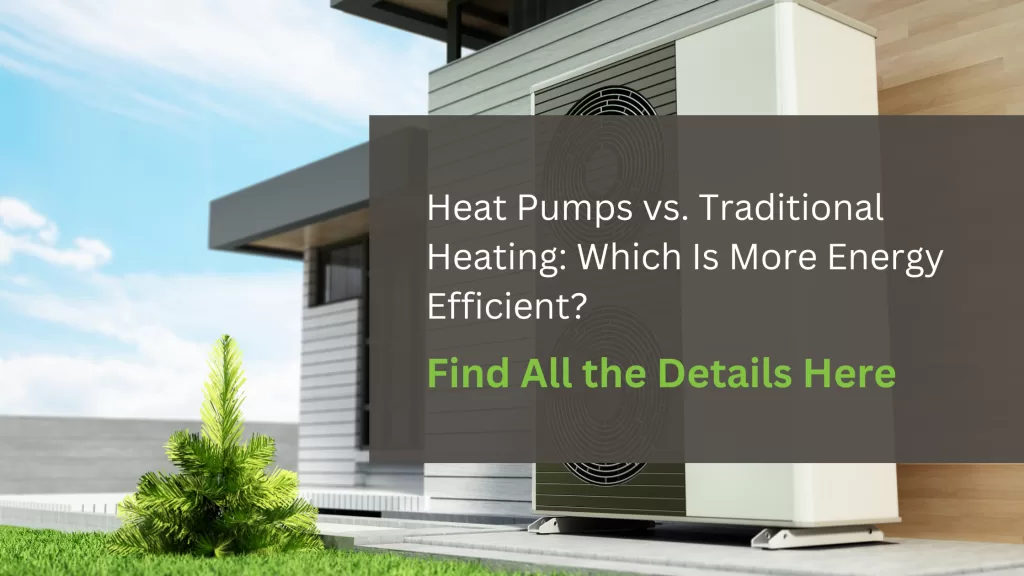The debate between heat pumps and traditional heating systems continues as homeowners look for ways to reduce energy bills and lower their carbon footprint. Choosing the right heating system can significantly impact energy efficiency, home comfort, and long-term savings. In this blog, we’ll compare heat pumps with conventional heating methods such as gas furnaces, electric resistance heaters, and boilers to determine the more energy-efficient option.
1. Understanding Heat Pumps and Traditional Heating
a) What Are Heat Pumps?
A heat pump is an energy-efficient heating and cooling system that transfers heat rather than generating it. Using refrigerant cycles, heat pumps extract heat from the outside air (even in cold temperatures) and transfer it indoors during winter. In summer, they reverse the process to provide cooling.
Types of heat pumps include:
- Air-source heat pumps (ASHPs) – Extract heat from the outside air.
- Ground-source heat pumps (GSHPs) – Use underground temperatures for heating and cooling.
- Hybrid heat pumps – Combine heat pump technology with traditional heating systems.
b) What Are Traditional Heating Systems?
Traditional heating systems generate heat by burning fuel or using electrical resistance. Common types include:
- Gas furnaces – Burn natural gas to produce heat.
- Oil or propane furnaces – Use fuel combustion for heating.
- Electric resistance heaters – Convert electricity into heat (baseboard heaters, space heaters).
- Boilers – Heat water to provide steam or hot water for home heating.
2. Energy Efficiency Comparison
a) Heat Pump Efficiency
Heat pumps are significantly more energy-efficient than traditional heating systems because they transfer heat rather than produce it. They can achieve 300%–400% efficiencies, meaning they provide three to four times more heat than the electricity they consume.
- Seasonal Coefficient of Performance (SCOP): Heat pumps typically have a SCOP rating of 3.0–5.0, meaning they generate 3 to 5 units of heat per unit of electricity.
- Lower operating costs: Heat pumps use less energy than electric resistance heating and gas furnaces, reducing energy consumption.
b) Traditional Heating Efficiency
Traditional heating systems have lower efficiency levels:
- Gas furnaces – Modern high-efficiency gas furnaces can achieve 90%–98% Annual Fuel Utilization Efficiency (AFUE), but older models operate at around 70%.
- Electric resistance heaters – Convert 100% of electricity into heat, but since electricity generation can be inefficient, they often result in higher energy costs.
- Boilers – High-efficiency condensing boilers can reach 90%–95%, but older units may only be 60%–70% efficient.
3. Cost Considerations: Installation and Operating Costs
a) Heat Pump Costs
- Upfront costs: Higher initial investment (typically $4,000–$10,000 for an air-source heat pump and $10,000–$25,000 for a ground-source heat pump).
- Operating costs: Lower monthly energy bills due to high efficiency.
- Maintenance: Regular servicing is required, but overall maintenance costs are reasonable.
b) Traditional Heating Costs
- Upfront costs: Lower initial investment for furnaces ($2,500–$7,500) and boilers ($3,500–$8,000).
- Operating costs: Gas furnaces are cheaper to run in areas with low natural gas prices but can be costly with rising fuel prices.
- Maintenance: Gas furnaces and boilers require regular servicing, including fuel supply checks.
4. Environmental Impact
a) Heat Pumps and Sustainability
- Lower carbon emissions: Heat pumps use electricity, which can be sourced from renewable energy, making them a greener option.
- Reduced dependence on fossil fuels: Unlike gas furnaces, heat pumps don’t rely on combustion, reducing CO2 emissions.
b) Traditional Heating and Environmental Concerns
- Gas and oil furnaces produce greenhouse gases, contributing to climate change.
- Electric resistance heating has a higher carbon footprint unless powered by renewable sources.
5. Climate Considerations: Which System Works Best for Your Region?
a) Heat Pumps in Cold Climates
- Modern cold-climate heat pumps can operate efficiently in temperatures as low as -20°F (-29°C).
- Supplementary heating (e.g., hybrid heat pumps) may be needed in icy areas.
b) Traditional Heating in Cold Climates
- Gas furnaces and boilers are reliable in extreme cold but have higher fuel costs.
- Electric resistance heating is inefficient for whole-home heating in cold regions.
6. Lifespan and Durability
- Heat pumps last about 15–20 years with proper maintenance.
- Gas furnaces and boilers last 15–30 years, but fuel price fluctuations can affect long-term costs.
7. Government Incentives and Rebates
- Many governments offer rebates, tax credits, and incentives for homeowners to install energy-efficient heat pumps.
- Programs such as the Victorian Energy Upgrades (VEU) in Australia and the Inflation Reduction Act in the U.S. provide financial support for heat pump adoption.
Which System Is Right for You?
Choose a Heat Pump If:
✅ You want higher energy efficiency and lower electricity consumption. ✅ You live in a mild to moderate climate (or a cold climate with a modern cold-climate heat pump). ✅ You prefer a lower carbon footprint and environmentally friendly heating. ✅ You’re willing to invest in higher upfront costs for long-term savings.
Choose a Traditional Heating System If:
✅ You live in a frigid climate where gas furnaces are more reliable. ✅ You have access to low-cost natural gas. ✅ You want a lower initial investment for home heating.
Conclusion:
Heat pumps are usually the more energy-efficient choice, offering lower operational costs and environmental benefits. However, homeowners in frigid climates may need to carefully weigh the pros and cons. Evaluating your energy needs, budget, and climate conditions will help determine the best system for your home.
At Optenergy, we believe energy efficiency should be accessible and cost-effective. That’s why we use the latest technology and industry best practices to deliver solutions that reduce energy consumption and improve indoor air quality and overall comfort. From eco-friendly cooling systems to customised commercial energy upgrades, our services are designed to meet the unique needs of every customer. Let us help you take the next step toward a greener, more energy-efficient future—contact us today!

